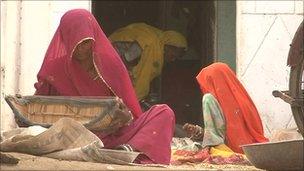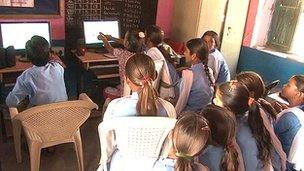Bringing the internet to rural India's business community
- Published
WATCH: Old meets new - high-speed internet access is helping rural farmers like Jeevan Ram Kharol get the best price for their grain
It's early morning in rural Rajasthan and the sun is already burning. Only the brave have ventured out into the harsh, radiating heat.
At the dusty Kanpura village, farmers are hard at work, grading their harvest. But the dry, still air is slowing them down. For Jeevan Ram Kharol, selling his produce is the only source of income.
Last year, the drought brought him no returns. Now he's hoping the harvest will earn him some cash. The closest market to his village is nearly 30km away, and the best way to get there is on a slow-moving cart.
Reaching remote, rural India
More than half of India's population live in rural areas and off-the-map villages.
Most are remote and too isolated to benefit from the country's impressive economic progress. Yet there's a growing desire among people in rural India to be part of its modernisation process.
"India is a country which has more than 600,000 villages and connecting these areas with internet broadband will have a paradigm shift," says Sachin Pilot, the minister of state for communications and information technology.

Those living in rural areas account for over half of the total population of India
Increasingly the government is looking at better ways to reach remote, rural India. And it is hoping that technology will provide a solution.
"It's time for our IT roots to go further inland and make sure that those areas which are tribal, rural and far-off geographically are brought to the ambit of the IT revolution," says Mr Pilot.
"It's the last-mile delivery that's always been a challenge for India."
India's digital divide
While the country boasts the world's second fastest-growing mobile market, it is lagging behind when it comes to internet connectivity.
According to a new study by the British risk analysis firm, Maplecroft, India is at 'extreme risk' from a lack of 'digital inclusion.'
The country's IT revolution is sometimes thought to benefit only the better off. According to the study, a lack of digital inclusion could hamper the country's economic potential as well.

The government is trying to educate people about the advantages the internet brings, says Sachin Pilot
But while India is trailing the BRIC nations of Brazil, Russia and China in the drive to get its population connected to digital technologies, the government says it has big plans.
By 2014, it wants to connect 160m Indians to hi-speed internet.
Through a range of public services, it's hoping to bridge the digital divide and bring awareness to those who are missing out on India's IT revolution.
"The challenge before all of us is to create the demand among people to want these data-heavy intensive services," says Mr Pilot.
"We are trying to educate the people, make it a demand driven process where the villagers in far-off areas are expecting and wanting that connectivity. And then they will be able to pay some price for that."
Connecting the masses
At the panchayat (council) office, villagers are huddled around the computer terminal, watching barley prices rise.

Farmers checking what the market rate is that day for their produce
Through optical fibre networks, the government has connected Kanpura village to broadband internet.
In fact, the village swam its way to limelight late last year when President Obama spoke to its residents through video-conferencing during his visit to India. It was one of the few villages in rural Rajasthan to have internet connectivity.
Now, its farmers are benefiting most from the internet service being provided at the panchayat (council) office. By regularly visiting the web kiosk, they can easily access agricultural data and regular updates on market prices.
The village computer terminals are free of cost and help farmers like Jeevan Ram Kharol to negotiate better prices at the local market.
"The Mandi (wholesale market) is very far from our village and we never know what the market prices are. So when we visit the Mandi, we have to bargain with the middlemen who don't offer us the best price," says Jeevan Ram Kharol.
"But now that our village has this internet kiosk, we first come here to check the daily rates, and know how much to sell our produce for. It's helped me save money."
India's untapped market
For many years, rural India has been a somewhat untapped market. But now the race to reach the remotest parts of the country is picking up pace among the private sector.
With urban markets more than saturated, the telecoms industry has its eyes set on India's villages. Companies big and small are looking at innovative ways to move deeper into the country's hinterland.

Education and health are also benefiting from the roll-out of high-speed internet access
From education to health and agriculture, businesses are hoping that internet will provide a range of services to its rural customers.
"In many of the rural markets, people don't venture out from their comfort zone so all these devices will give them an opportunity to experiment what is available in the urban land," says M. Srikaunth, the associate vice-president of Sai Infosystem.
The Indian IT firm has partnered with state-run telecom operator BSNL to roll out video telephony. The company says its technology will provide a range of essential services like telemedicine and tele-education to rural communities.
Microqual, a company that builds wireless sites across India says the telecom industry should tap into the rural market by providing economically viable solutions.
"India is a big country. Every 200 kilometres we are changing language and culture," says its CEO, Mahesh Choudhary,
"There has to be a common platform to connect rural India and there's nothing better to have communication do that."
Digital dream
Hundreds of millions of Indians call rural and remote India home. Many of them live and work in tiny and distant villages across the country.
Experts have long said that technology will play a critical role in providing services to the remotest parts of India.
If done correctly it could open up a new market, connecting big businesses with the smallest of villages - all at the push of a button.